Eakins Oval
Introduction
Text-to-speech Audio
Located on the Benjamin Franklin Parkway, directly in front of the beautiful main building of the Philadelphia Museum of Art, Eakins Oval is a traffic circle surrounded by public spaces, fountains, monuments, and public art. The circle gets its name from famed Philadelphia painter Thomas Eakins (1844-1916), a realist painter, photographer, sculptor, and fine arts educator generally regarded as one of the most influential artists in American art history. Moreover, Eakins' work, taken en masse, offers an overview of Philidelphia's intellectual life during the late nineteenth and early twentieth centuries. Today, the public space hosts "The Oval," a an eight-acre seasonal pop-up park with community programming.
Images
The Washington Monument, sculpted by Rudolf Siemering, in Eakins Oval, just in front of the stairs of the Philadelphia Museum of Art,
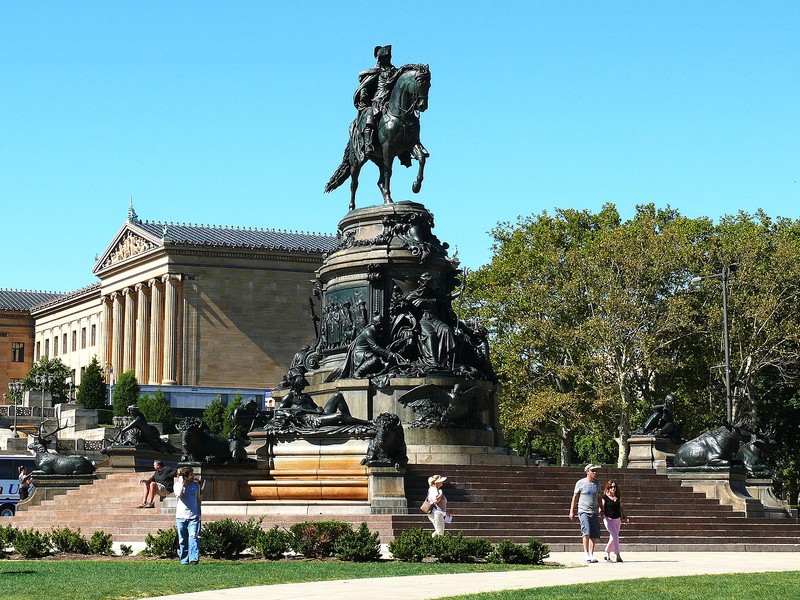
Eakins Oval traffic circle.
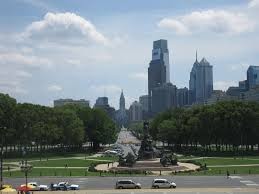
The Oval offers a wide array of activities and amenities, and features park spaces that all ages can easily access and enjoy.
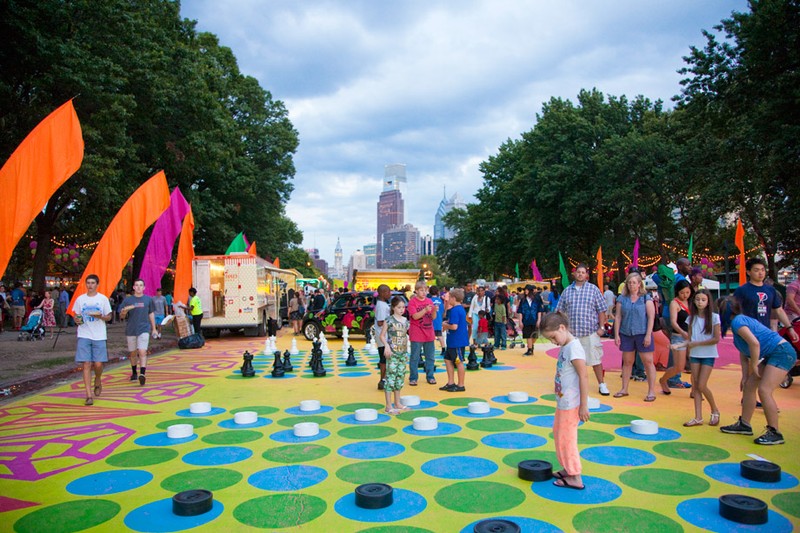
Thomas Eakins Painting: Miss Amelia Van Buren, c. 1891
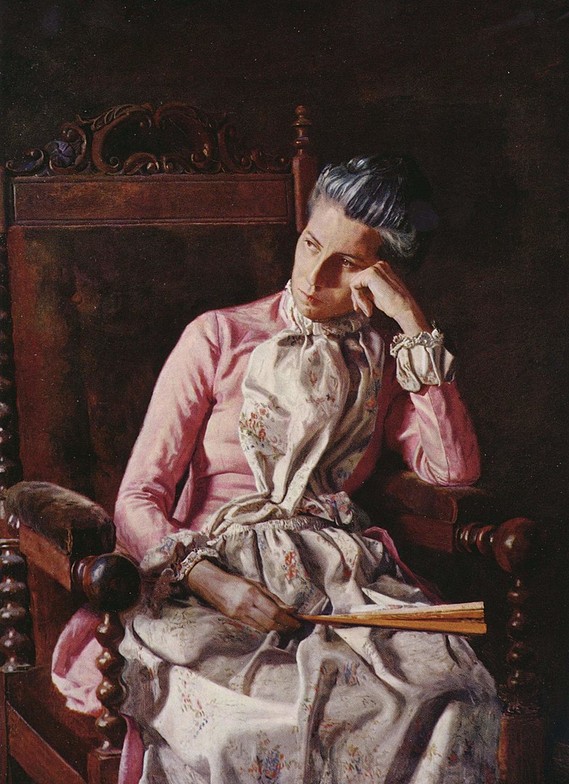
Thomas Eakins Painting: The Swimming Hole, c. 1884.
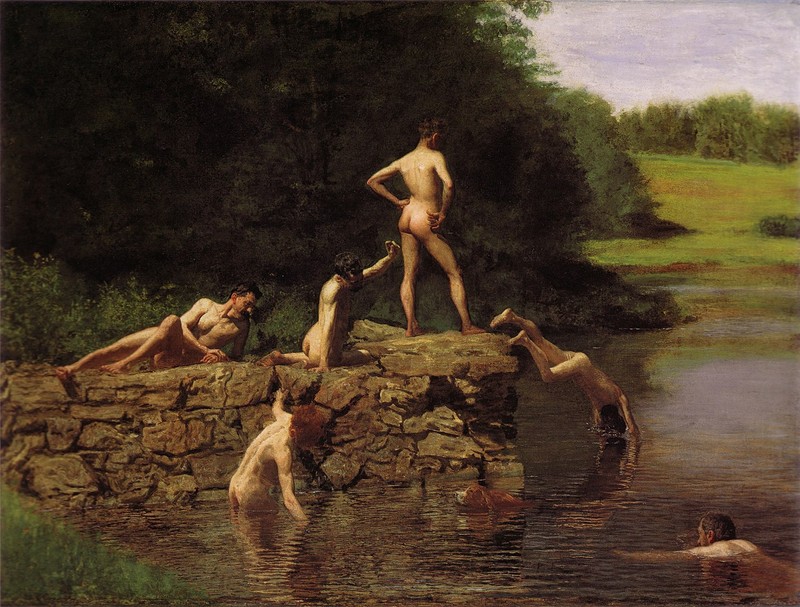
One of Thomas Eakins' most well-known paintings: The Gross Clinic, 1875–76
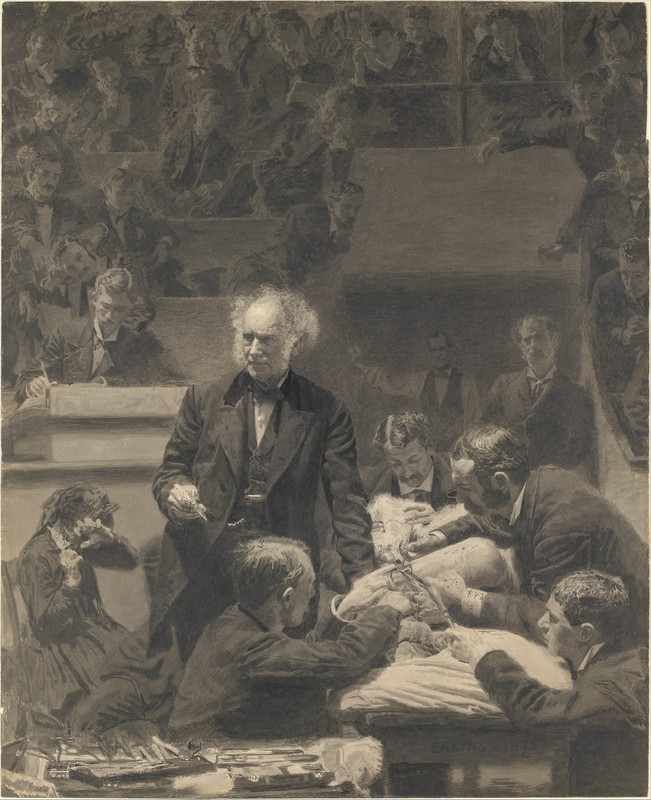
Backstory and Context
Text-to-speech Audio
Throughout his career, which spanned from the early 1870s until the early 1910s, Eakins painted several hundred portraits, usually featuring his friends, family, or prominent artists, scientists, medical professionals, and theologians. In addition to his artwork, Eakins attended Jefferson Medical College to study anatomy and went on to teach anatomy and painting at the Pennsylvania Academy of Fine Arts. However, his fascination with the human body in its purest form got him in trouble. Eakins' deemed nudity as an essential element of academic study, which did not please Philadelphia's Victorian-minded society. In January 1886, lecturing about the pelvis to a class that included female students, Eakins removed a male model's loincloth in order to trace the course of a muscle. Far less progressive-minded portions of the academic community protested, forcing him to resign. Nevertheless, his artistic pursuits and success continued, and his passion for the human form returned by the 1880s when he returned to the subject of athletics, notably boxers, wrestlers, and rowers, gaining him much acclaim. Overall, his work conveys the history of Philadelphia's intellectual life and culture during the late nineteenth and early twentieth centuries.
The oval named for Eakins, and its many features, are the work of the city parks department and Fairmount Park Conservancy. Eakins' namesake plaza features three fountains, the centerpiece being a sculpture dedicated to George Washington, which possesses its own unique history. In 1783, at the City Tavern in Philadelphia, The Society of the Cincinnati of Pennsylvania was founded to commemorate War of Independence veterans; George Washington served as the society's president from 1783 - 1799. On Independence Day in 1810, the organization decided to create a memorial to General George Washington. However, it took nearly an entire century for the memorial to come to fruition. The monument is constructed in three zones or levels, each representing a different concept. Washington (the hero) sits at the top level while allegorical figures depicting his time are on the middle section and, finally, flora and fauna at the lowest layer. The four figures and the animals overlooking the pools at the base represent four great waterways of America: Mississippi, Potomac, Delaware, and Hudson. The monument was unveiled on May 5, 1897, in Fairmount Park, with President McKinley in attendance for the dedication ceremony.
The Eakins Oval's physical design and roadway configuration have changed substantially since its original design as a bonafide oval with tight radii that slowed traffic and maintained a symmetrical plan. Additionally, following the completion of the Benjamin Franklin Parkway in 1928, officials moved the Washington Monument to its present location at the terminus of the thoroughfare in front of the Philadelphia Museum of Art. In 1957, the city stretched the oval and smoothed its curves, resulting in a high-speed traffic circle whose byproduct consisted of a disorganized public space with a surface parking lot in the center. Since 2013 "The Oval," a seasonal pop-up, eight-acre park with community programming, events, and activities, was founded at Eakins Oval (at the center of the Ben Franklin Parkway). With The Oval's focus on family-friendly fun, the pedestrian-friendly urban oasis is within walking distance from Parkway's cultural attractions, including the Philadelphia Museum of Art, The Barnes Foundation, and The Franklin Institute.
Sources
Lubin, David. “Projecting an Image: The Contested Cultural Identity of Thomas Eakins.” The Art Bulletin 84, no. 3 (2002): 510–22.
Parkway Council. Accessed December 16, 2022. https://www.parkwaycouncilfoundation.org/.
Swartz, Laura. "Eakins Oval Is Returning As a Summertime Pop-Up Festival. The Oval XP will bring activities, a beer garden, and a giant Ferris wheel to the Parkway this summer." Philadelphia Magazine. June 9, 2022. https://www.phillymag.com/things-to-do/2022/06/09/the-oval-xp-parkway-2022/.
"Thomas Cowperthwait Eakins Biography in Details." Thomas Cowperthwait Eakins. thomaseakins.org. Accessed December 16, 2022. https://www.thomaseakins.org/biography.html.
"Washington Monument (1897), by Rudolf Siemering (1835 - 1905)." Association for Public Art. 2022. https://www.associationforpublicart.org/artwork/washington-monument/.
Weinberg, H. Barbara. "Thomas Eakins (1844–1916): Painting." In Heilbrunn Timeline of Art History. New York: The Metropolitan Museum of Art, October 2004. http://www.metmuseum.org/toah/hd/eapa/hd_eapa.htm.
By Ken Thomas - KenThomas.us(personal website of photographer), Public Domain, https://commons.wikimedia.org/w/index.php?curid=2814921
https://myphillypark.org/what-we-do/programs/oval/
By Thomas Eakins - The Yorck Project (2002) 10.000 Meisterwerke der Malerei (DVD-ROM), distributed by DIRECTMEDIA Publishing GmbH. ISBN: 3936122202., Public Domain, https://commons.wikimedia.org/w/index.php?curid=150591
By Thomas Eakins - 1. whitmanarchive.org2. Scanned from Bolger, Doreen; Cash, Sarah; et al. Thomas Eakins and the Swimming Picture. Amon Carter Museum, 1996. ISBN 0-88360-085-4, Public Domain, https://commons.wikimedia.org/w/index.php?curid=116980
The Metropolitan Museum of Art (The Met) in New York: https://www.metmuseum.org/art/collection/search/10815
